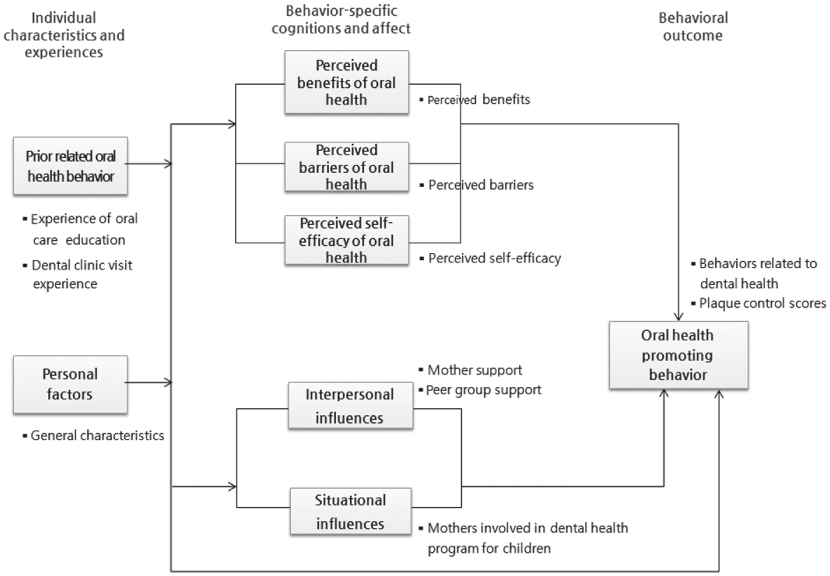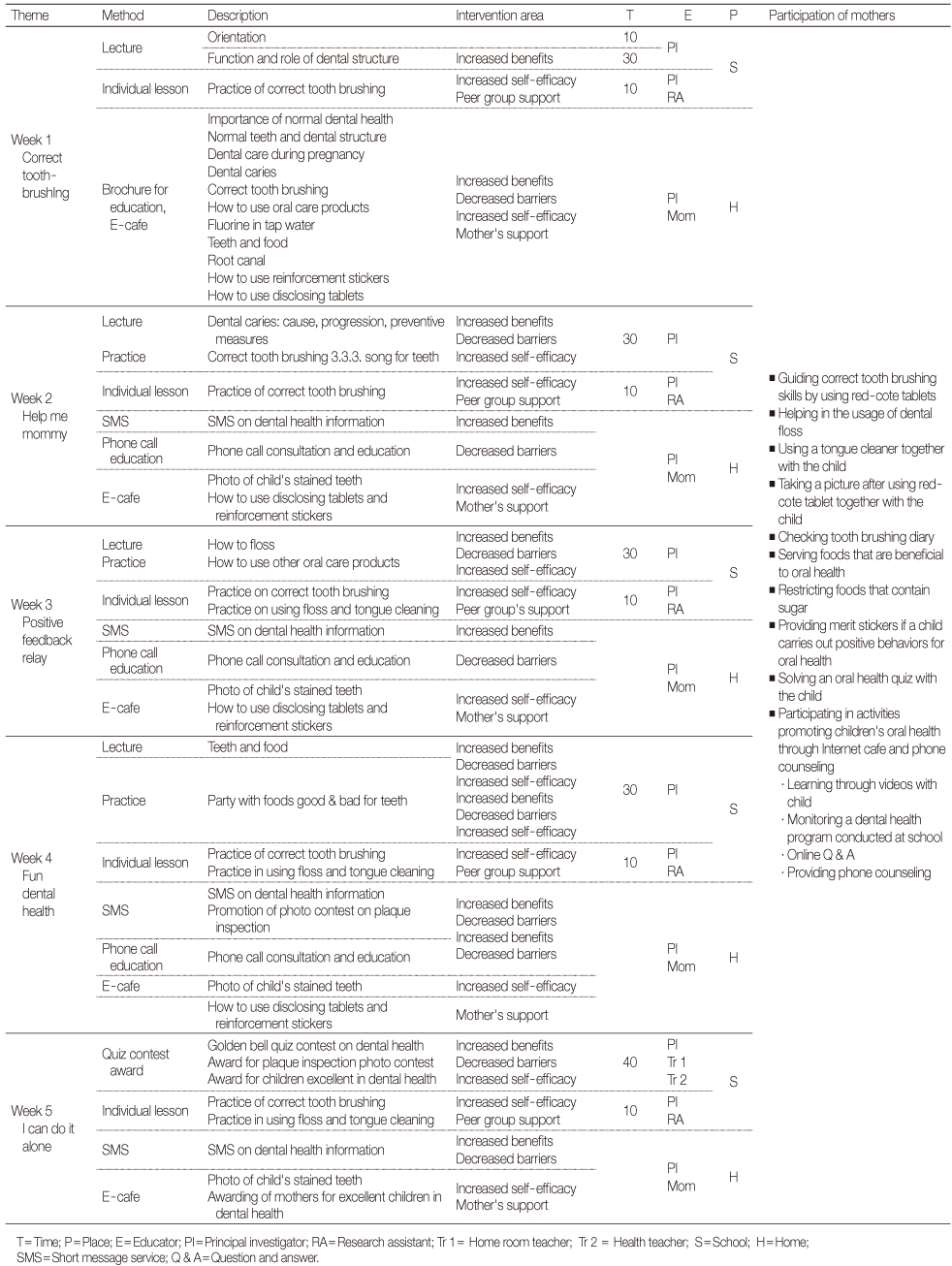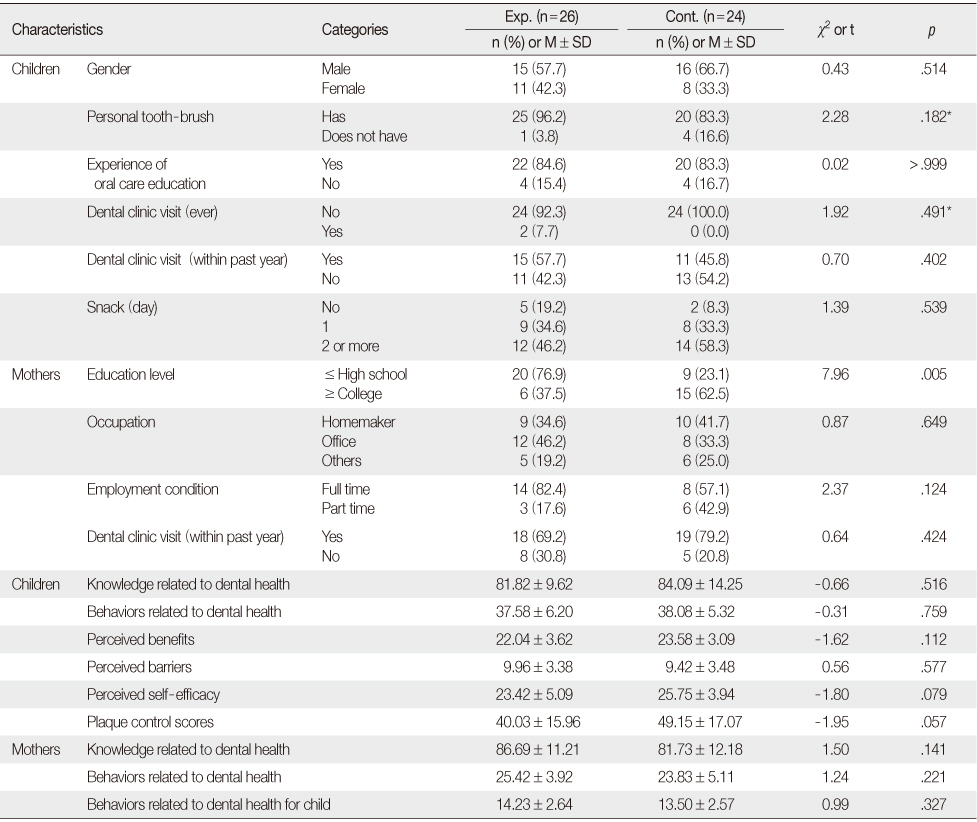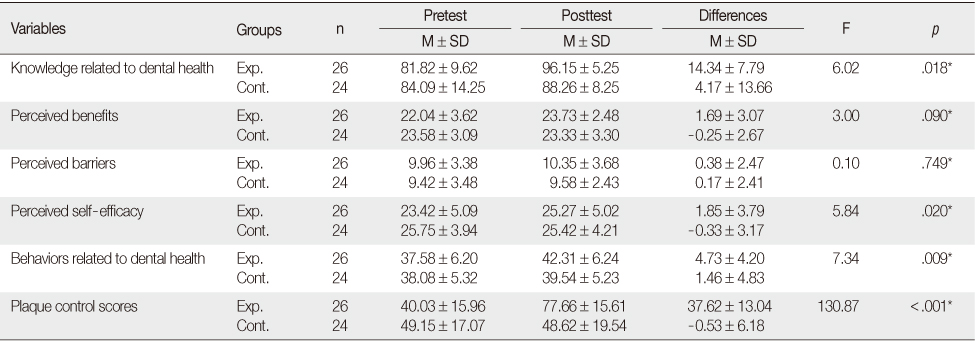Articles
- Page Path
- HOME > J Korean Acad Nurs > Volume 42(7); 2012 > Article
-
Original Article
- Effects of Mothers Involved in Dental Health Program for Their Children
- Hye Seon Choi, Hye Young Ahn
-
Journal of Korean Academy of Nursing 2012;42(7):1050-1061.
DOI: https://doi.org/10.4040/jkan.2012.42.7.1050
Published online: December 31, 2012
1Department of Nursing, Kimcheon Science College, Kimcheon, Korea.
2College of Nursing, Eulji University, Daejeon, Korea.
- Address reprint requests to: Ahn, Hye Young. College of Nursing, Eulji University, 771-71 Beon-gil, Gyeryong-ro, Jung-gu, Daejeon 301-746, Korea. Tel: +82-42-259-1715, Fax: +82-42-259-1709, ahanaya@eulji.ac.kr
© 2012 Korean Society of Nursing Science
- 878 Views
- 2 Download
- 7 Crossref
Abstract
-
Purpose
- The purpose of this study was to identify the effects of mothers' involvement in a dental health program for their elementary school children.
-
Methods
- This study was a non-equivalent control group pre-post test design in which knowledge and behaviors related to dental health, perceived benefits and barriers, self-efficacy and plaque control scores were compared between the experimental group (n=26) for whom the dental health program included the direct involvement of the mothers, and the control group (n=24) for whom knowledge related to dental health was provided through brochures.
-
Results
- Scores for the experimental group in which the mothers were involved in the dental health program were significantly higher for knowledge, behaviors in dental health, self-efficacy and plaque control compared to the control group.
-
Conclusion
- Results of this study suggest that mothers involvement in the dental health program is effective in reinforcing dental health enhancing behavior in elementary school children.
INTRODUCTION
METHODS
1) Knowledge related to dental health
2) Perceived benefits
3) Perceived barriers
4) Perceived self-efficacy
5) Behaviors related to dental health
6) Plaque control scores
Disclosing tablet: Product name is Red-Cote Tablet (Sunstar Americas-GUM, Chicago, U.S.A). It reacts with layer of bacteria formed on tooth surface and dyes the tooth red.
Plaque Control Scores: This is score computed from quantifying whether plaque has built up and stained or not when all teeth are dyed with the stainer. All teeth are subject to this treatment and whether or not plaque build-up exists is evaluated for each of the 4 areas. After evaluating each tooth with plaque score of 0-4, O'Leary plaque index is obtained by percentage from dividing the total score by number of tooth sides inspected, which is then subtracted from 100. Higher the number signifies better plaque control score, which means tooth brushing is properly done. Evaluation method for quantification is as follows (Eom, Jeong, & Park, 2009).
RESULTS
DISCUSSION
CONCLUSION
- 1. Ahn HY, Yi GM. Application of dental health program for elementary school children. J Korean Acad Child Health Nurs. 2010;16(1):49–55. http://dx.doi.org/10.4094/jkachn.2010.16.1.49.Article
- 2. Ahn YM, Yun JM, Kim HH, Seo MY, Yeom MK. Effects of dental health education on dental health knowledge and dental hygiene status in preschoolers. J Korean Acad Child Health Nurs. 2009;15(2):201–209. http://dx.doi.org/10.4094/jkachn.2009.15.2.201.Article
- 3. Ahn YS, Lee YS, Ryu DY. Study of oral health-related quality of life index for primary school oral health program. J Dent Hyg Sci. 2006;6(2):79–84.
- 4. Arora A, Scott JA, Bhole S, Do L, Schwarz E, Blinkhorn AS. Early childhood feeding practices and dental caries in preschool children: A multi-centre birth cohort study. BMC Public Health. 2011;11:28. http://dx.doi.org/10.1186/1471-2458-11-28.PubMedPMC
- 5. Chae SH, Kim BO, Jang HS, Kim DK, Lee BJ. The effect of maintenance care on periodontitis patients. Oral Biol Res. 2009;33(1):8–16.
- 6. Chang KW, Kim JB. Oral health survey: Basic methods. 2007;4th ed. Seoul, Komoonsa.
- 7. Choi YK, Park DY. Public health dentistry: Comparison of rolling method with Bass' method toothbrushing practices for efficacy in plaque removal and degree of easiness. J Korean Acad Dent Health. 2008;32(3):329–338.
- 8. Chung YS, Lee JY, Lee KY. School health. 2004;3th ed. Seoul, Hyunmoonsa.
- 9. Dupont WD, Plummer WD. Power and sample size calculations: A review and computer program. Control Clin Trials. 1990;11:116–128. http://dx.doi.org/10.1016/0197-2456(90)90005-M.PubMed
- 10. Eom MR, Jeong DB, Park DY. Enhancement of plaque control score following individualized repeated instruction. J Korean Acad Dent Health. 2009;33(1):10–18.
- 11. Hartono SW, Lambri SE, van Palenstein Helderman WH. Effectiveness of primary school-based oral health education in West Java, Indonesia. Int Dent J. 2002;52(3):137–143. http://dx.doi.org/10.1111/j.1875-595X.2002.tb00618.x.ArticlePubMed
- 12. Health Insurance Review & Assessment Service. Information of disease. The most frequent disease. The most frequent disease of outpatient care 2006. 2006;Retrieved October 10, 2011. from http://www.hira.or.kr.
- 13. Hockenberry MJ, Wilson D. Wong's essentials of pediatric nursing. 2008;8th ed. New York, Elsevier.
- 14. Hong YR. A structural model for health promotion on 6th grade elementary school students in Korea. J Korean Acad Community Health Nurs. 2006;17(1):102–111.
- 15. Jo MJ. Effect of repeated directing tooth-brushing education on plaque control score. 2010;Daegu, Keimyung University. Unpublished doctoral dissertation.
- 16. Jun BH, Choi YS, Cho YS. The effects of parent's oral care on children. J Korean Acad Dent Health. 2009;33(2):211–226.
- 17. Kang BH, Park SN, Sohng KY, Moon JS. Effect of a tooth-brushing education program on oral health of preschool children. J Korean Acad Nurs. 2008;38(6):914–922. http://dx.doi.org/10.4040/jkan.2008.38.6.914.ArticlePubMed
- 18. Kim JB, Choi YJ, Mun HS, Kim JB, Kim DK, Lee HS, et al. Public health dentistry. 2009;4th ed. Seoul, Komoonsa.
- 19. Kim JS, Kang EJ, Choi MH. A study on oral health knowledge and oral health behavior of elementary school student in some regions. J Korean Soc Dent Hyg. 2010;10(3):523–530.
- 20. Kim KW. The percentage of adolescents who brush their teeth after lunch and its related factors. J Korean Soc Dent Hyg. 2010;10(3):441–448.
- 21. Lee NH, Park IH. A study on the effects of social reinforcement in peer groups on children's dental health behavior. J Korean Soc Sch Health. 2000;13(1):117–129.
- 22. Lee YK. A study on mothers' oral health knowledge and oral health management behavior of children. J Korean Soc Dent Hyg. 2010;10(1):93–106.
- 23. Min HH, Min SH. Effects on the school dental clinic operation for children's oral health. J Korean Soc Dent Hyg. 2010;10(3):495–502.
- 24. Ministry of Health & Welfare. Analysis of Korea national oral health survey 2006. 2007;Seoul, Author.
- 25. O'Leary TJ, Drake RB, Naylor JE. The plaque control record. J Periodontol. 1972;43(1):38. http://dx.doi.org/10.1902/jop.1972.43.1.38.ArticlePubMed
- 26. Pender NJ. Health promotion in nursing practice. 1996;3rd ed. Stamford, CT, Appleton & Lange.
- 27. Son MH. Effects of oral health education program on the oral health knowledge, oral health behavior and oral hygiene status of elementary school students. J Korean Acad Community Health Nurs. 2003;14(1):24–35.
- 28. Tickle M, Milsom KM, Donaldson M, Killough S, O'Neill C, Crealey G, et al. Protocol for Northern Ireland caries prevention in practice trial (NIC-PIP) trial: A randomised controlled trial to measure the effects and costs of a dental caries prevention regime for young children attending primary care dental services. BMC Oral Health. 2011;11:27. http://dx.doi.org/10.1186/1472-6831-11-27.PubMedPMC
- 29. Yi GM, Hyun HJ. A study on knowledge of oral health, behavior, self-efficacy, belief, and the number of dental caries of elementary school students. J Korean Acad Community Health Nurs. 2009;20(4):531–539.
- 30. Yoo JS, Chang KW, Kim YS. Development and practice of a health-oral health combined education program. J Korean Acad Dent Health. 2010;34(2):169–177.
- 31. Zahra SM. Oral health among Iranian preadolescents: A school-based health education intervention. 2010;Helsinki, Finland, University of Helsinki, Faculty of Medicine.
REFERENCES
Figure & Data
REFERENCES
Citations

- Effects of an educational intervention based on the health belief model on COVID-19 preventive behaviors among health personnel in Abadan, Iran
Ali Khani Jeihooni, Amin Namdari, Seyyed Mansour Kashfi, Amirhossein Kamyab, Pooyan Afzali Harsini, Tayebeh Rakhshani
Journal of Public Health.2025; 33(4): 769. CrossRef - COMPARATIVE EVALUATION OF DIFFERENT EDUCATIONAL AIDS IN ASSESSING PARENTAL ATTITUDE TOWARDS CHILD’S ORAL HEALTH
Anupama Kajal, Sandeep Tondon, Tripti Sharma Rai, Chahita Mahesh Lalchandani
Journal of Indian Dental Association.2020;[Epub] CrossRef - One-to-one oral hygiene advice provided in a dental setting for oral health
Francesca A Soldani, Thomas Lamont, Kate Jones, Linda Young, Tanya Walsh, Rizwana Lala, Janet E Clarkson
Cochrane Database of Systematic Reviews.2018;[Epub] CrossRef - Longitudinal study into the determining factors of dental caries in children aged 4: socio-behavioral aspects and oral health of pregnant women
Najara Barbosa ROCHA, Cléa Adas Saliba GARBIN, Artênio José Isper GARBIN, Orlando SALIBA, Suzely Adas Saliba MOIMAZ
RGO - Revista Gaúcha de Odontologia.2017; 65(1): 52. CrossRef - Community-based population-level interventions for promoting child oral health
Andrea M de Silva, Shalika Hegde, Bridget Akudo Nwagbara, Hanny Calache, Mark G Gussy, Mona Nasser, Hannah R Morrice, Elisha Riggs, Pamela M Leong, Lisa K Meyenn, Reza Yousefi-Nooraie
Cochrane Database of Systematic Reviews.2016;[Epub] CrossRef - Promoting Oral Health in 6-12 Year-Old Students: A Systematic Review
Seyed Mohammad Mehdi Hazavehei, Samane Shirahmadi, Malihe Taheri, Nesa Noghan, Nafese Rezaei
Journal of Education and Community Health.2014; 1(4): 66. CrossRef - Impact of an Oral Health Education Workshop on Parents’ Oral Health Knowledge, Attitude, and Perceived Behavioral Control among African Immigrants
Maryam Amin, Pawan Nyachhyon, Maryam Elyasi, Muhammed Al-Nuaimi
Journal of Oral Diseases.2014; 2014: 1. CrossRef


Figure 1
Figure 2
Homogeneity Test for General Characteristics between Experimental and Control Groups
*Fisher's exact test; Exp.=Experimental group; Cont.=Control group.
Differences in Dependent Variables between Experimental and Control Groups
*ANCOVA (covariate: education level of mothers=13.62 years)
Exp.=Experimental group; Cont.=Control group.
*Fisher's exact test; Exp.=Experimental group; Cont.=Control group.
*ANCOVA (covariate: education level of mothers=13.62 years) Exp.=Experimental group; Cont.=Control group.
 KSNS
KSNS
 E-SUBMISSION
E-SUBMISSION





 Cite
Cite

